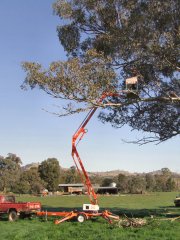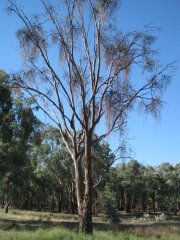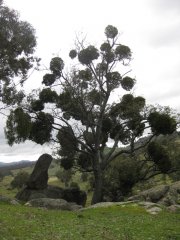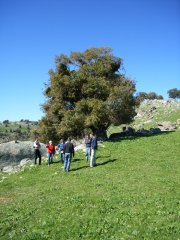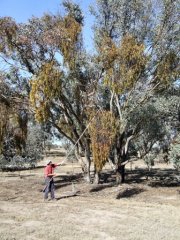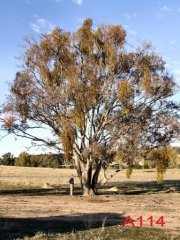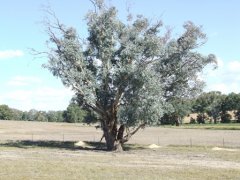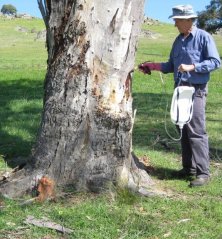Heavy infestations of Mistletoe (Amyema app.) are contributing to death or poor health of important shade, shelter and fodder trees throughout our area. Some trees carry Mistletoe loads of 20+ per tree and Mistletoe loads of 10+ per tree are common. Red Box (Eucalyptus polyanthemos), Grey Box (E. macrocarpa), Blakeleys Red Gum (E. macrocarpa) and Kurrajong (Brachychiton populneus) seem particularly susceptible though some White Box (E. Albens) and Yellow Box (E. melliodora) are also affected.
While infecting Mistletoe are Australian natives and important habitat and/or food sources for native birds and possums, they are also reducing biodiversity by resulting in the death of important tree species. We noted conflicting cause / effect debate in the literature on whether Mistletoe results in poor tree health and/or death or whether pastoral activity results in trees being in poor health and therefore more susceptible to Mistletoe infection. Mistletoe researcher, Dr David Watson at CSU believes that the Mistletoe ‘explosion’ is related in part to the loss of possums and shrub understory from the pastoral environment. In our area, large important paddock trees, new trees in recent plantings from which livestock are excluded and trees in significant areas of lightly grazed remnant vegetation are affected. Trees with heavy Mistletoe load (and there seems to be a tree size/ Mistletoe load factor at work here) have been observed to die within a few years.
Loss of important shade and shelter trees would lead to lambing / calf losses, reduced weight gains for young stock and increased heat / cold stress for older animals. Kurrajong are regularly browsed by both sheep and cattle and are an important fodder source in dry times.
In a three year project, HCLG looked at physical thinning or complete removal of Mistletoe from Eucalypts and Kurrajong using several pruning techniques, ground spraying of Mistletoe with either 2,4-D or Roundup and tree trunk injection of 2,4-D using a technique developed by CSIRO researchers during the 1950’s. A copy of our research report is attached.
The project was cofounded by Meat and Livestock Australia (MLA) through its Producer Initiated Research Development Program.
Our conclusions:
- Eucalypts carrying >6 mistletoe ( fair / poor health) are vulnerable to further decline and death, especially in dry seasons
- Kurrajong seem able to carry heavier mistletoe loads, but >30 mistletoe results in tree health decline
- Physical pruning of mistletoe in large paddock Eucalypts is high cost ($60 - $240 per tree) and warranted only for high value trees
- Mistletoe on trees up to 6 metre high can be cost effectively pruned from the ground using pole saws.
- Trees from which all mistletoe is removed do respond quickly, even in dry seasons
- 2,4-D tree trunk injection is a cost effective option for large paddock Eucalypts (not Kurrajong) with heavy mistletoe loads – but trees in poor health and with high mistletoe loads my still die.
- Recommend treating a few trees first to gain local experience
Hovells Creek Field Day Presentations
Download: Field Day Article (684kb)
Download: Ecology and Management by Assoc. Professor Nick Reid, University of New England, Armidale


